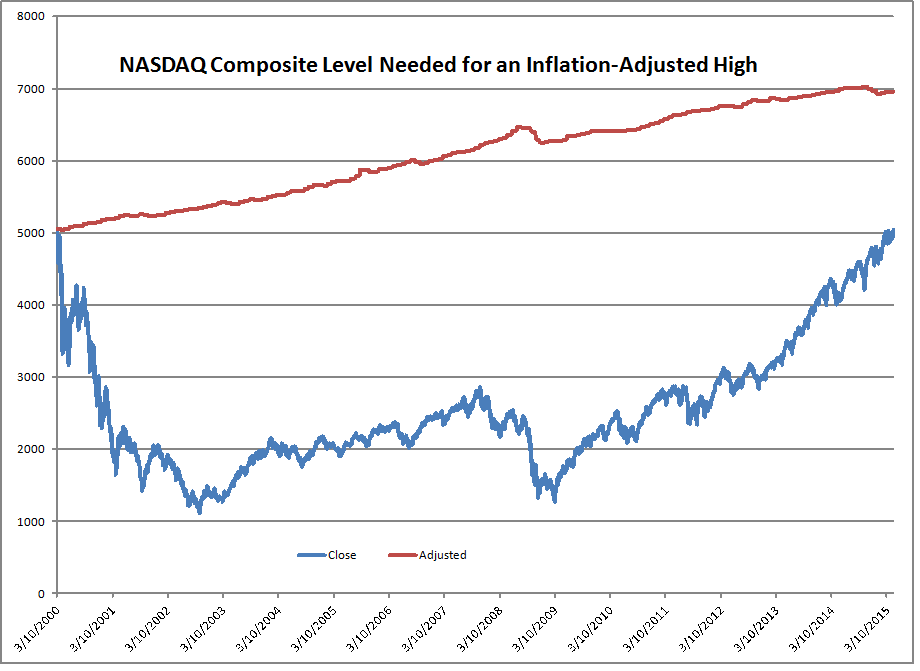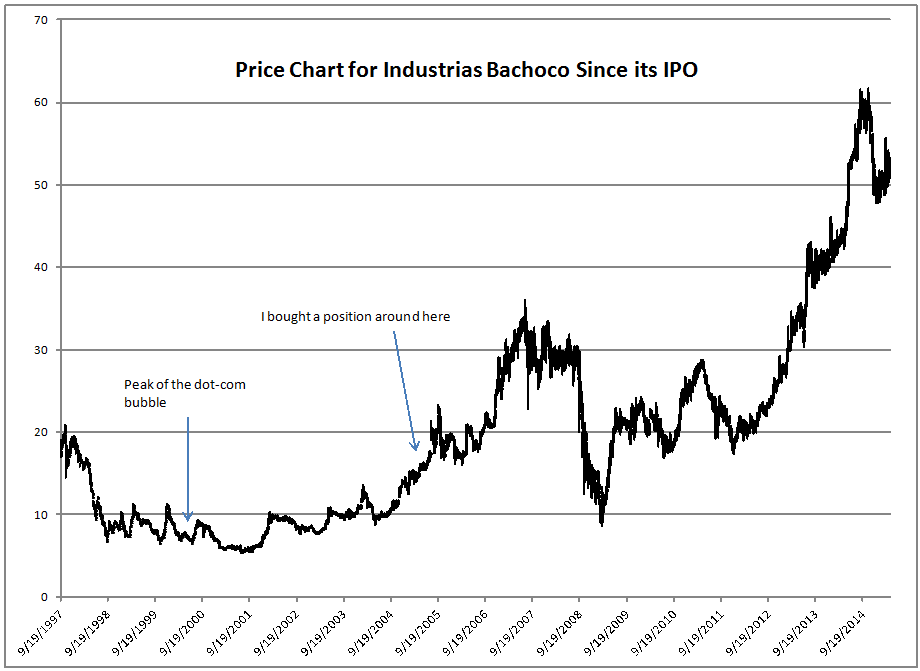2000 More Points To Go; Look Elsewhere!

15 years is a long time to wait for a 1%/yr return
The big news of the day is that the NASDAQ Composite hit a new high for the first time in 15 years. Nice, except as you note from the above graph, that if you adjusted for inflation, you still haven’t made a new high. By the time the NASDAQ Composite hits a new high, it will have to rack up at least another 2000 points, which is 40% or so away. Now if you add dividends back in since March 10th, 2000, you get to roughly a 1% return.
That’s a lot of pain for not much gain. That said, few if any rode out this storm in a fund like the NASDAQ composite. The pain would have been so great that most would have given up in 2002, and those that survived would have given up in 2008-9. We aren’t designed to take that much pain and hold on. I have a stronger financial pain tolerance than most, and I can’t think of a stock I hung on to past a 75% decline that ever came back in full. 50%? Yes. 75%? No.
I haven’t run the dollar-weighted return calculation for the QQQ, but I’ll try to run that calculation in a future blog post, and who knows, maybe I will run the calculation for John Hussman’s main fund at some future point also.
Look Elsewhere
Looking at the NASDAQ Composite is more a glimpse at the past rather than the future. But let me take two more glimpses at the past before I give you a guess at the future.
I remember March 10th, 2000, and the months around it. As the dot-com bubble expanded, what industry did the worst, and bounced back the hardest? Property/Casualty Insurance. I tell my story in detail in this post that I find amusing. To shorten this article, I can tell you that if you invested in undervalued industries in 2000-2001, you didn’t get hurt badly at all; you may even have made money like me. 2002 was another matter — everything got smashed.
But many famous value investors never got to participate in that rally, because they got fired, or retired amid the furor of the dot-com bubble. This is yet another reason why it is so hard as an asset manager to hold onto promising assets that are out of favor… if your clients leave you because they can’t take any more pain, you will be forced to liquidate because of them. If you are a big enough holder of those assets, the process may drive the price down further, adding insult to injury.
In my own case, I got derided by peers in early 2000 by owning a lot of property/casualty insurers, particularly my own company, The St. Paul (now part of the Travelers (TRV)).
Here’s another glimpse: Sometime in 2005, I got introduced to a company called Industrias Bachoco [IBA]. It was a medium-sized chicken producer based in Celaya, Mexico. Today, I believe it is second to Tyson Foods in North America as far as chicken production goes.
It looked interesting and underfollowed, in an industry that I thought had good prospects, because in a world with a growing middle class, meat would be a premium food product in demand. So I bought some, and mostly held on.

Yummy Chicken, no?
If you had bought IBA on March 10th, 2000, and held until today, you would have gotten a little more than a 17%/year return. 4% of that came from dividends. Not quite a Peter Lynch 10-bagger from that point, but getting closer by the day.
Because I got there later, my returns haven’t been as good as that, but still well worth owning over the last ten years. I highlight IBA because I know it well, and it serves as a good example of a winning stock that few would have been likely to choose. Agriculture is not a sexy industry, whereas technology gets lots of admirers. But with an intelligent management team and conservative finances, IBA has done very well. Now, what will do well in the future?
This is why I tell you to look elsewhere for ideas, away from the crowds. Not that everything will do as well as IBA did, but where are the good assets that few are looking at?
Tough question. I’ll give you a few ideas, but then you have to work on it yourself.
1) Look at higher quality names in out-of-favor industries. The advantage of this approach is that your downside is likely to be limited, while the upside could be significant. I’ve seen it work many times. Note: avoid “buggy whip” industries where the decline is final; the internet is eating a lot of industries.
2) Look at companies outside the US that act in the best interests of outside, passive, minority investors like you and me. There is less competition there from analysts and clever US-focused investors. Note: spend extra time analyzing how they have used free cash flow in the past. Is management rational at allocating capital, or even clever?
3) Look at firms that can’t be taken over, where a control investor seems savvy, and acts in the best interests of outside, passive, minority investors. Many won’t invest in those firms because they are less liquid, and a takeover is very unlikely.
4) Look at smaller firms pursuing a growing niche in an otherwise dull industry. Or smaller firms that have good finances, but have some taint that keeps investors from re-examining it.
5) Look through 13F filings for new names that look promising, before too many people learn about the company. Or, IPOs and spin-offs in industries that are dull.
6) Analyze stocks that are in the lowest quartile of performance over the last 3-5 years.
7) Or, go to Value Line, and look at the stocks with the highest appreciation potential, with an adequate safety rank.
Regardless, look forward from here, and look at assets that are cheap relative to future prospects that few others are looking at. There is little value in searching where everyone else does, such as the main stocks in the NASDAQ Composite.
Disclosure: Long IBA and TRV for clients and me.
Disclaimer: David Merkel is an investment professional, and like every investment professional, he makes ...
more


